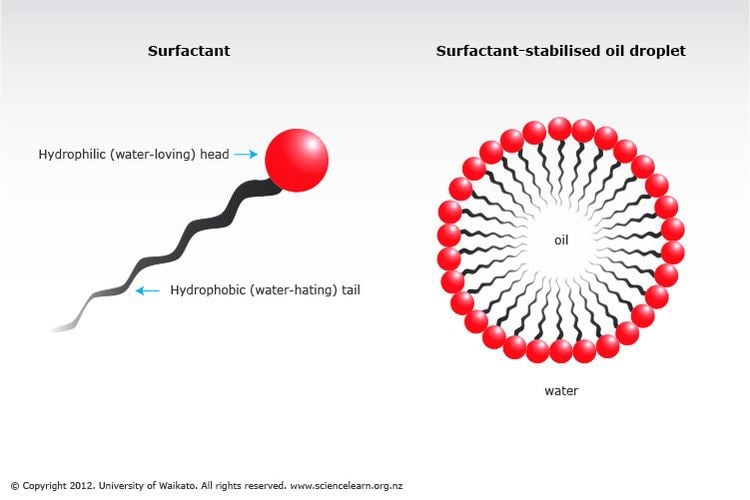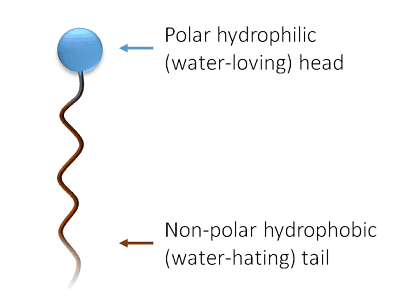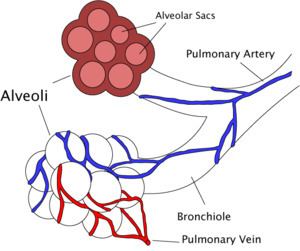 | ||
Surfactants cosmetic science in 300 seconds
Surfactants are compounds that lower the surface tension (or interfacial tension) between two liquids or between a liquid and a solid. Surfactants may act as detergents, wetting agents, emulsifiers, foaming agents, and dispersants.
Contents
- Surfactants cosmetic science in 300 seconds
- Surfactant why do surfactants make water adsorbable by a dry soil
- Etymology and definition
- Composition and structure
- Structure of surfactant phases in water
- Dynamics of surfactants at interfaces
- Characterization of interfaces and surfactant layers
- Detergents in biochemistry and biotechnology
- Classification
- Sulfate sulfonate and phosphate esters
- Carboxylates
- Cationic head groups
- Zwitterionic surfactants
- Nonionic surfactant
- According to the composition of their counter ion
- In pharmacy
- Current market and forecast
- Health and environmental controversy
- Biosurfactants
- Safety and environmental risks
- Biosurfactants and Deepwater Horizon
- Applications
- References

Surfactant why do surfactants make water adsorbable by a dry soil
Etymology and definition
The term surfactant is a blend of surface active agent.

In the United States National Library of Medicine's Medical Subject Headings (MeSH) vocabulary, surfactant is reserved for the meaning pulmonary surfactant. For the more general meaning, surface active agent/s is the heading.
Composition and structure

Surfactants are usually organic compounds that are amphiphilic, meaning they contain both hydrophobic groups (their tails) and hydrophilic groups (their heads). Therefore, a surfactant contains both a water-insoluble (or oil-soluble) component and a water-soluble component. Surfactants will diffuse in water and adsorb at interfaces between air and water or at the interface between oil and water, in the case where water is mixed with oil. The water-insoluble hydrophobic group may extend out of the bulk water phase, into the air or into the oil phase, while the water-soluble head group remains in the water phase.

World production of surfactants is estimated at 15 Mton/y, of which about half are soaps. Other surfactants produced on a particularly large scale are linear alkylbenzenesulfonates (1700 kton/y), lignin sulfonates (600 kton/y), fatty alcohol ethoxylates (700 ktons/y), and alkylphenol ethoxylates (500 kton/y).
Structure of surfactant phases in water

In the bulk aqueous phase, surfactants form aggregates, such as micelles, where the hydrophobic tails form the core of the aggregate and the hydrophilic heads are in contact with the surrounding liquid. Other types of aggregates can also be formed, such as spherical or cylindrical micelles or lipid bilayers. The shape of the aggregates depends on the chemical structure of the surfactants, namely the balance in size between hydrophilic head and hydrophobic tail. A measure of this is the HLB, hydrophilic-lipophilic balance. Surfactants reduce the surface tension of water by adsorbing at the liquid-air interface. The relation that links the surface tension and the surface excess is known as the Gibbs isotherm.
Dynamics of surfactants at interfaces

The dynamics of surfactant adsorption is of great importance for practical applications such as in foaming, emulsifying or coating processes, where bubbles or drops are rapidly generated and need to be stabilized. The dynamics of adsorption depend on the diffusion coefficient of the surfactant. As the interface is created, the adsorption is limited by the diffusion of the surfactant to the interface. In some cases, there can exist an energetic barrier to adsorption or desorption of the surfactant. If such a barrier limits the adsorption rate, the dynamics are said to be ‘kinetically limited'. Such energy barriers can be due to steric or electrostatic repulsions. The surface rheology of surfactant layers, including the elasticity and viscosity of the layer, play an important role in the stability of foams and emulsions.
Characterization of interfaces and surfactant layers

Interfacial and surface tension can be characterized by classical methods such as the -pendant or spinning drop method. Dynamic surface tensions, i.e. surface tension as a function of time, can be obtained by the maximum bubble pressure apparatus
The structure of surfactant layers can be studied by ellipsometry or X-Ray reflectivity.
Surface rheology can be characterized by the oscillating drop method or shear surface rheometers such as double-cone, double-ring or magnetic rod shear surface rheometer.
Detergents in biochemistry and biotechnology
In solution, detergents help solubilize a variety of chemical species by dissociating aggregates and unfolding proteins. Popular surfactants in the biochemistry laboratory are SDS and CTAB. Detergents are key reagents to extract protein by lysis of the cells and tissues: They disorganize the membrane's lipidic bilayer (SDS, Triton X-100, X-114, CHAPS, DOC, and NP-40), and solubilize proteins. Milder detergents such as octyl thioglucoside, Octyl glucoside or dodecyl maltoside are used to solubilize membrane proteins such as enzymes and receptors without denaturing them. Non-solubilized material is harvested by centrifugation or other means. For electrophoresis, for example, proteins are classically treated with SDS to denature the native tertiary and quaternary structures, allowing the separation of proteins according to their molecular weight.
Detergents have also been used to decellularise organs. This process maintains a matrix of proteins that preserves the structure of the organ and often the microvascular network. The process has been successfully used to prepare organs such as the liver and heart for transplant in rats. Pulmonary surfactants are also naturally secreted by type II cells of the lung alveoli in mammals.
Classification
The "tail" of most surfactants are fairly similar, consisting of a hydrocarbon chain, which can be branched, linear, or aromatic. Fluorosurfactants have fluorocarbon chains. siloxane surfactants have siloxane chains.
Many important surfactants include a polyether chain terminating in a highly polar anionic group. The polyether groups often comprise ethoxylated (polyethylene oxide-like) sequences inserted to increase the hydrophilic character of a surfactant. Polypropylene oxides conversely, may be inserted to increase the lipophilic character of a surfactant.
Surfactant molecules have either one tail or two; those with two tails are said to be double-chained.
Most commonly, surfactants are classified according to polar head group. A non-ionic surfactant has no charged groups in its head. The head of an ionic surfactant carries a net positive, or negative charge. If the charge is negative, the surfactant is more specifically called anionic; if the charge is positive, it is called cationic. If a surfactant contains a head with two oppositely charged groups, it is termed zwitterionic. Commonly encountered surfactants of each type include:
Sulfate, sulfonate, and phosphate esters
Anionic surfactants contain anionic functional groups at their head, such as sulfate, sulfonate, phosphate, and carboxylates. Prominent alkyl sulfates include ammonium lauryl sulfate, sodium lauryl sulfate (sodium dodecyl sulfate, SLS, or SDS), and the related alkyl-ether sulfates sodium laureth sulfate (sodium lauryl ether sulfate or SLES), and sodium myreth sulfate.
Others include:
Carboxylates
These are the most common surfactants and comprise the alkyl carboxylates (soaps), such as sodium stearate. More specialized species include sodium lauroyl sarcosinate and carboxylate-based fluorosurfactants such as perfluorononanoate, perfluorooctanoate (PFOA or PFO).
Cationic head groups
Zwitterionic surfactants
Zwitterionic (amphoteric) surfactants have both cationic and anionic centers attached to the same molecule. The cationic part is based on primary, secondary, or tertiary amines or quaternary ammonium cations. The anionic part can be more variable and include sulfonates, as in the sultaines CHAPS (3-[(3-Cholamidopropyl)dimethylammonio]-1-propanesulfonate) and cocamidopropyl hydroxysultaine. Betaines such as cocamidopropyl betaine have a carboxylate with the ammonium. The most common biological zwitterionic surfactants have a phosphate anion with an amine or ammonium, such as the phospholipids phosphatidylserine, phosphatidylethanolamine, phosphatidylcholine, and sphingomyelins.
Nonionic surfactant
Many long chain alcohols exhibit some surfactant properties. Prominent among these are the fatty alcohols, cetyl alcohol, stearyl alcohol, and cetostearyl alcohol (consisting predominantly of cetyl and stearyl alcohols), and oleyl alcohol.
According to the composition of their counter-ion
In the case of ionic surfactants, the counter-ion can be:
In pharmacy
A wetting agent is a surfactant that, when dissolved in water, lowers the advancing contact angle, aids in displacing an air phase at the surface, and replaces it with a liquid phase. Examples of application of wetting to pharmacy and medicine include the displacement of air from the surface of sulfur, charcoal, and other powders for the purpose of dispersing these drugs in liquid vehicles; the displacement of air from the matrix of cotton pads and bandages so that medicinal solutions can be absorbed for application to various body areas; the displacement of dirt and debris by the use of detergents in the washing of wounds; and the application of medicinal lotions and sprays to surface of skin and mucous membranes.
Current market and forecast
The annual global production of surfactants was 13 million tonnes in 2008. In 2014, the world market for surfactants reached a volume of more than 33 billion US-dollars. Market researchers expect annual revenues to increase by 2.5% per year to around 40.4 billion US-dollars until 2022. The commercially most significant type of surfactants is currently the anionic surfactant alkyl benzene sulfonate (LAS), which is widely used in cleaners and detergents.
Health and environmental controversy
Surfactants are routinely deposited in numerous ways on land and into water systems, whether as part of an intended process or as industrial and household waste. Some of them are known to be toxic to animals, ecosystems, and humans, and can increase the diffusion of other environmental contaminants. As a result, there are proposed or voluntary restrictions on the use of some surfactants. For example, PFOS is a persistent organic pollutant as judged by the Stockholm Convention. Additionally, PFOA has been subject to a voluntary agreement by the U.S. Environmental Protection Agency and eight chemical companies to reduce and eliminate emissions of the chemical and its precursors.
The two major surfactants used in the year 2000 were linear alkylbenzene sulfonates (LAS) and the alkyl phenol ethoxylates (APE). They break down in the aerobic conditions found in sewage treatment plants and in soil to the metabolite nonylphenol, which is thought to be an endocrine disruptor.
Ordinary dishwashing detergent, for example, will promote water penetration in soil, but the effect would last only a few days (many standard laundry detergent powders contain levels of chemicals such as alkali and chelating agents that can be damaging to plants and should not be applied to soils). Commercial soil wetting agents will continue to work for a considerable period, but they will eventually be degraded by soil micro-organisms. Some can, however, interfere with the life-cycles of some aquatic organisms, so care should be taken to prevent run-off of these products into streams, and excess product should not be washed down.
Anionic surfactants can be found in soils as the result of sludge application, wastewater irrigation, and remediation processes. Relatively high concentrations of surfactants together with multimetals can represent an environmental risk. At low concentrations, surfactant application is unlikely to have a significant effect on trace metal mobility.
Biosurfactants
Biosurfactants are surface-active substances synthesised by living cells. Interest in microbial surfactants has been steadily increasing in recent years due to their diversity, environmentally friendly nature, possibility of large-scale production, selectivity, performance under extreme conditions, and potential applications in environmental protection. A few of the popular examples of microbial biosurfactants includes Emulsan produced by Acinetobacter calcoaceticus, Sophorolipids produced by several yeasts belonging to candida and the starmerella clade, and Rhamnolipid produced by Pseudomonas aeruginosa etc.
Biosurfactants enhance the emulsification of hydrocarbons, have the potential to solubilise hydrocarbon contaminants and increase their availability for microbial degradation. The use of chemicals for the treatment of a hydrocarbon polluted site may contaminate the environment with their by-products, whereas biological treatment may efficiently destroy pollutants, while being biodegradable themselves. Hence, biosurfactant-producing microorganisms may play an important role in the accelerated bioremediation of hydrocarbon-contaminated sites. These compounds can also be used in enhanced oil recovery and may be considered for other potential applications in environmental protection. Other applications include Herbicides and pesticides formulations, detergents, healthcare and cosmetics, pulp and paper, coal, textiles, ceramic processing and food industries, uranium ore-processing, and mechanical dewatering of peat.
Several microorganisms are known to synthesise surface-active agents; most of them are bacteria and yeasts. When grown on hydrocarbon substrate as the carbon source, these microorganisms synthesise a wide range of chemicals with surface activity, such as glycolipid, phospholipid, and others. These chemicals are synthesised to emulsify the hydrocarbon substrate and facilitate its transport into the cells. In some bacterial species such as Pseudomonas aeruginosa, biosurfactants are also involved in a group motility behavior called swarming motility.
Safety and environmental risks
Most anionic and nonionic surfactants are nontoxic, having LD50 comparable to sodium chloride. The situation for cationic surfactants is more diverse. Dialkyldimethylammonium chlorides have very low LD50's (5 g/kg) but alkylbenzyldimethylammonium chloride has an LD50 of 0.35 g/kg. Prolonged exposure of skin to surfactants can cause chafing because surfactants (e.g., soap) disrupts the lipid coating that protects skin (and other) cells.
Biosurfactants and Deepwater Horizon
The use of biosurfactants as a way to remove petroleum from contaminated sites has been studied and found to be safe and effective in the removal of petroleum products from soil. Other studies found that surfactants are often more toxic than the oil that is being dispersed, and the combination of the oil and the surfactant can be more toxic than either alone. Biosurfactants were not used by BP after the Deepwater Horizon oil spill. However, unprecedented amounts of Corexit (active ingredient: Tween-80), were sprayed directly into the ocean at the leak and on the sea-water's surface, the theory being that the surfactants isolate droplets of oil, making it easier for petroleum-consuming microbes to digest the oil.
Biosurfactants produced by microbe or bacteria can be used to enhance oil production by microbial enhanced oil recovery method (MEOR).
Applications
Surfactants play an important role as cleaning, wetting, dispersing, emulsifying, foaming and anti-foaming agents in many practical applications and products, including:
